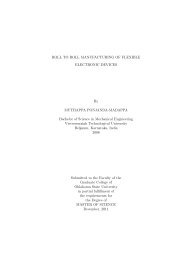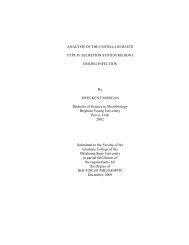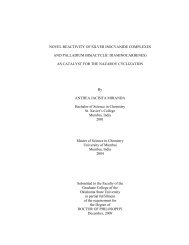DESIGN, ASSEMBLY AND CHARACTERIZATION OF COMPOSITE ...
DESIGN, ASSEMBLY AND CHARACTERIZATION OF COMPOSITE ...
DESIGN, ASSEMBLY AND CHARACTERIZATION OF COMPOSITE ...
Create successful ePaper yourself
Turn your PDF publications into a flip-book with our unique Google optimized e-Paper software.
modify the sintering kinetics of the Ni(m) ink, so that co-sintering of BT and Ni(m) may<br />
be accomplished at a higher Ni volume fraction than the BT:Ni=4:1 composition. The<br />
evolution of the NiO during sintering process is not studied in detail, but it is likely that<br />
the NiO will be reduced to metal state eventually. However, this method is not considered<br />
a repeatable standard procedure, and frequently hard to control due to process variables<br />
involved. Thus, it is not described in the experimental section.<br />
Figure 5.10a shows composite lattices assembled with pure BT ink and<br />
BT:Ni=2:3 Ni(m) ink using Ø250 µm nozzle and annealed at 800 °C for 24 hours in N2.<br />
The layered pattern is designed such that interleaved layers of BT and Ni(m) form a<br />
structure similar to a multilayer capacitor. That is, the Ni(m) layers are alternately<br />
terminated to form electrodes. The BT:Ni=2:3 Ni(m) rods appear gray in color, whereas<br />
the BT rods are cream colored. The center sample has been demarcated with a numerical<br />
scheme along the bottom edge. Here, regions 1 represent the termination ends of the<br />
multilayer structure. Region 2 denotes the extension of one set of electrodes to the<br />
terminations. And, region 3 represents the active area of the multilayer structure where<br />
layers of dielectric are sandwiched between oppositely charged electrodes. The electrode<br />
scheme is more clearly demonstrated with the cross-section of Figure 5.10b. In this figure,<br />
the open, 3D lattice nature of the structure is apparent. The top numbers correspond with<br />
the regions demarcated in Figure 5.10a, whereas the left-hand side labels denote the<br />
various anode (a1, a2, etc.), dielectric (d1, d2, etc.), and cathode (c1, c2, etc.) layers. In<br />
this picture, the terminal end is connected to the anode layers.<br />
The intersections created by overlapping rods from adjacent anode, dielectric, and<br />
cathode layers form an array of parallel connected capacitors for each dielectric layer.<br />
159





